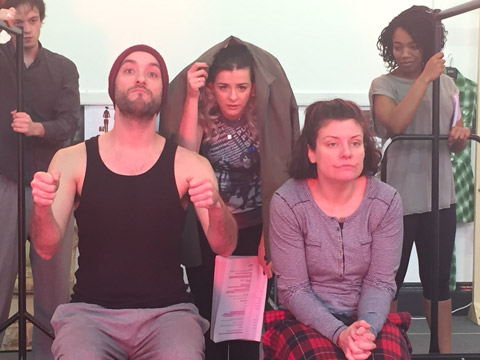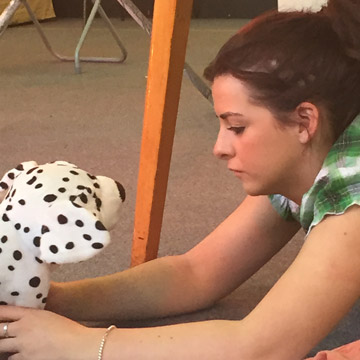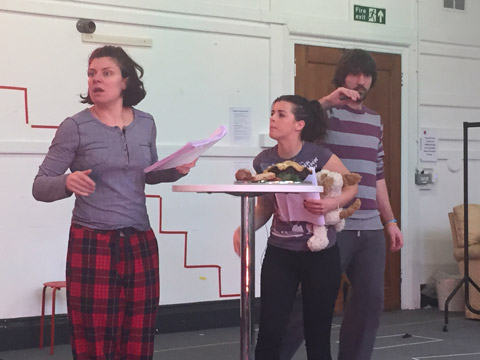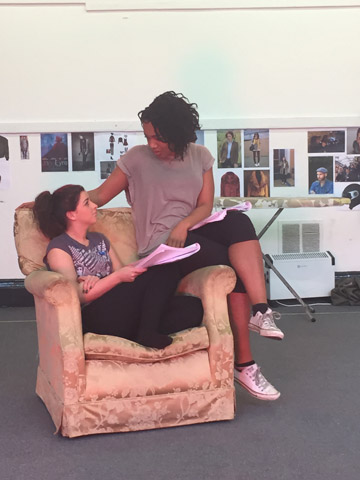

We’ve been sitting in on rehearsals for Derby Theatre’s world premier of Solace of the Road, which opens at Derby Theatre on the 27thFebruary 2015.
The play tells the story of Holly Hogan as she runs away from her foster home and, as her alter-ego Solace, travels across England to find her real mam… and so begins a journey through memories, discovering her true self, and unlocking the secrets of her past.
Sarah Brigham is directing this play, which has been adapted by Mike Kenny from the novel by Siobhan Dowd.
As theatre makers who usually create work for studio spaces, this is a great opportunity for us to see how things work on a larger scale and the different considerations this demands.
Sarah’s philosophy for this show is underpinned by the responsibility towards serving this story and the characters within it – especially that of Holly and the other ‘care babes’.
‘Solace’ is a play primarily aimed at a younger audience and has had these people in mind from the outset. Derby Theatre’s has worked in an exemplary manner to engage with children in care across Derbyshire through the development of this piece. Children in care have been into rehearsals and worked alongside the company to help inform this piece and the characters we meet. There are currently over 70,000 children in care in the UK and this vital new piece of work uses humour, imagination and courage to tell just one of these stories.
In the rehearsal Room:
Sarah Brigham is working with an ensemble of 6 actors and although only one week in – the feel of this piece is already emerging and taking shape. Rebecca Ryan and Polly Lister are no strangers to Derby Theatre having performed in ‘Taste of Honey’ and ‘Cooking with Elvis’ respectively. Neil Craig, Jack Finch, Robert Vernon and Naomi Ackie complete the cast.
The first day of rehearsals kicked off with a read through of the script with the whole team (including all Derby Theatre and University of Derby staff) This clearly assists with the staff feeling part of the process and being well equipped to spread the word to existing and new audiences. Set designer, Barney George shared his vision for the play and wowed with 3-D sketches of the concept. Having been privy to earlier design meets its great to see how the design has developed from initial discussions.
Despite the rehearsal room at Green Lane being especially cold, Sarah immediately creates a warm environment through games and ‘play’ to help the company start to bond.
We sit with Mike Kenny and start to explore the story. We choose one word to encapsulate the play and think about questions we may have for the characters and the playwright. We picked one moment from the play or an image that came to mind and wrote it in as much detail as possible, as a sort of stream of consciousness. This was a useful way in to help start and facilitate discussion about the piece of a whole.
In order to give more insight and make some decisions we created a chronological timeline of Holly’s life from the age of zero to 14 – the point at which we meet her at the beginning of the play. We listed significant events and elaborated on who was in her life at that point. This gave the team an agreed and ‘shared’ history and a concrete reference about what may have affected our protagonist up to this point. This information might not always pay off in present action but provides clues that Sarah reminds the cast of when exploring scenes.
The play is on its feet swiftly to draw an overall shape. The text work happens throughout the exploration of the scenes as opposed to the round table approach at this stage. Sarah allows time for the actors to live within this world and to explore the space, rehearsing the scenes in broad-brush strokes before focusing on particular choices or intentions moment to moment.
Improvisations happen naturally as we read each scene before putting it on its feet. The company makes quick decisions. A mantra Sarah repeats is ‘it’s right for today’. This helpful language allows the company to make decisions in the moment but not to be tied to them. It’s structured flexibility. We are clear that things will shift and change and again Sarah’s language indicates this ‘that’s good for a first draft’.
Sarah asks the actors specific questions and sets practical tasks in order for them to begin to find the world of the play and to think about this ‘for themselves’ at first. Tasks included thinking about each character’s ‘belief systems’, which, again, can be drawn on when moving onto action and when the characters need to make certain choices. The actors completed some of the following questions.
Men are…
Women are….
Children are…
Life is…
I am…..
If the character of Grace believes ‘All men are….. A disappointment this may inform how she interacts with the men she meets. Her energy and judgments would play out differently if she felt all men are… a threat, for example.
The walls of the rehearsal room are adorned with an ever-increasing amount of character and other relevant research including our timelines, our belief systems and our super objectives. These are physically present and Sarah is able toremind the actors of these when making choices or shaping a scene.
The world of Solace:
We are in the world of semiotics and sign. The characters we meet are responsible for helping to tell Holly’s story and the audience is her confidante. Early on there is a discussion around the nature of how we see these characters and Sarah clarifies that Holly paints the characters, as she perceives them. “We are playing with extremes, we are not necessarily finding real versions of all the individuals” Much of the story takes place in Holly’s mind and we see how these characters are drawn within Holly’s ‘fantasy’ world.
We explore the idea of the ‘storytelling’ mode identifying when are we telling the ‘physical’ story and when we are telling the ‘emotional ‘ story. The relationship with the audience is also key to this.
In order to help with the storytelling the ensemble can come into play in a variety of ways. For example. There is a moment where Holly is having a conversation with foster mum Fiona, and is mocking her. Sarah places Holly’s two friends Trim and Grace into the scene for her to react to (they are egging her on). This brings the moment to life and helps with Holly’s intention. Trim and Grace are removed from the scene but the intention remains and is crystal clear.
Ensemble:
The play’s structure, the doubling/tripling and even quadrupling of roles, the notion of the ensemble and the set design all lean toward the importance of finding a fluidity within the piece. On day one the ensemble begin to explore their physicality and the possibilities within this. We played with the notion of physicalizing emotional proximity. Our protagonist Holly stands in the middle of the room and positions characters near or far from her to denote their connection to her world and emotional state. The discoveries that came from this helped to paint a picture of the complex relationships that exist for Holly and how she sees the people in her life.
By Day 5 of rehearsals the actors are able to ‘stagger through’ Act 1. Now this has been shaped physically, the company can turn its attention to delve more deeply to develop a more shaped biography for the characters. Ultimately Sarah is encouraging the company to find their characters’ super objective (the thing that drives everything they are doing) having now lived in them and the world for a while.
Conclusion:
While observing the process so far it has been appealing to think that there could be a way of leading a directing process free from dilemmas. The truth is directing is hard and the ‘right thing to do’ isn’t always obvious in advance. Sarah will use different tools and processes dependent on the company and the production. Judgments between guiding and telling, instructing and suggesting, stepping in and stepping back are arrived at moment to moment.







